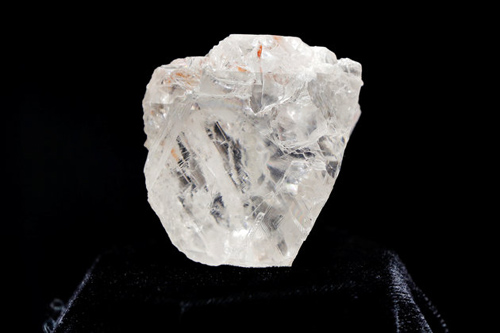
Vancouver-based Lucara Diamond Corp will pursue alternative market opportunities for its 1 109 ct Type IIa Lesedi La Rona diamond, which went unsold at a Sotheby’s auction, in London, at the end of last month.

Vancouver-based Lucara Diamond Corp will pursue alternative market opportunities for its 1 109 ct Type IIa Lesedi La Rona diamond, which went unsold at a Sotheby’s auction, in London, at the end of last month.
The Lesedi La Rona, the second-largest diamond ever recovered, after the Cullinan diamond, had been expected to sell for $70-million, but a bid of $61-million did not meet the undisclosed minimum reserve price.
The Type IIa precious gem, the largest recovered in more than a century, was discovered at Lucara’s flagship Karowe mine, in Botswana, in November last year. The diamond, which means ‘Our Light’, is the largest ever to be recovered through a modern processing facility and the newly installed large diamond recovery X-ray transmission machines.
Lucara has “no need” and was “in no rush” to sell the diamond, CEO William Lamb tells Mining Weekly.
Despite considerable hype before the auction – and a perceived negative market sentiment after – Lamb stresses that Lucara maintains optionality on the stone.
One option will be to sell the diamond in a similar transaction to that of ‘The Constellation’, an 812.77 ct diamond, which sold for $63.11-million in May. The Type IIa diamond was also recovered at Karowe, in November 2015.
Lucara had partnered with Nemesis International DMCC on the sale of ‘The Constellation’ and would retain a 10% interest in the net profit received from the sale of the resultant polished diamonds.
Other options under consideration include increased exposure of the Lesedi La Rona to the market by placing it on display at various museums over the next two years, Lamb says, adding that there has been significant interest from the trade.
Lucara, however, remains adamant that it wants to sell the diamond in the rough, with Lamb reiterating that “the stone is unique as it stands and I have always said it should remain unpolished”.
Before Lucara recovered Lesedi, a reputable diamond brokerfrom Europe told the company that, if it recovered a 1 000 ct stone, “the best thing we could do with it is pick it up, take it back into [the] pit and smash it with a hammer, because we would never ever sell it; no one would buy a 1 000 ct diamond”, Lucara COO Paul Day ironically revealed at theBotswana Resource Sector Conference, in Gaborone, two weeks ago.
Day consequently emphasised that Lucara’s “heart and soul had been put in proving the broker wrong”.
Although the diamond disappointingly did not fetch the expected auction price, Lamb highlights the value of the diamond, underscoring that Lucara owns a diamond that is worth at least $68.3-milllion. This value included Sothebys’ 12% fee, which would have been added to the price tag of $61-million.
Had the diamond achieved the expected sales price, it would have been “a world record and a phenomenal price”, according to Lamb. Moreover, it would have eclipsed the sale of ‘The Constellation’.
Despite Lucara’s stock falling more than 14% on the TSXafter the diamond went unsold, Lamb maintains that “Lucara has a strong balance sheet, no debt and good sales from regular goods and is in no financial position requiring the diamond to be sold”.
While 80% of Lucara’s revenue is derived from the sale of higher-value, single diamonds, the company still sees significant demand for large rough stones.